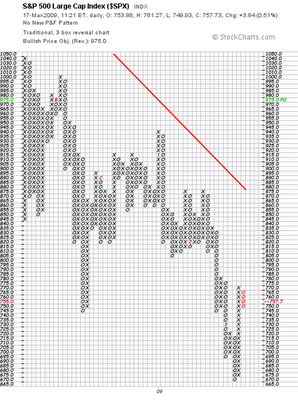Today the Federal Reserve and the US Treasury announced the launch of the "Term Asset-Backed Securities Loan Facility" or "TALF" for short. The purpose of TALF is to help "Main Street" get access to credit so consumers and small businesses can once again buy goods and services on credit. This is expected to significantly stimulate the economy.
From the
joint press release:
In carrying out the Financial Stability Plan, the Department of the Treasury and the Federal Reserve Board are announcing the launch of the Term Asset-Backed Securities Loan Facility (TALF), a component of the Consumer and Business Lending Initiative (CBLI). The TALF has the potential to generate up to $1 trillion of lending for businesses and households.
The TALF is designed to catalyze the securitization markets by providing financing to investors to support their purchases of certain AAA-rated asset-backed securities (ABS). These markets have historically been a critical component of lending in our financial system, but they have been virtually shuttered since the worsening of the financial crisis in October. By reopening these markets, the TALF will assist lenders in meeting the borrowing needs of consumers and small businesses, helping to stimulate the broader economy.
Under today's announcement, the Federal Reserve Bank of New York will lend up to $200 billion to eligible owners of certain AAA-rated ABS backed by newly and recently originated auto loans, credit card loans, student loans, and SBA-guaranteed small business loans. Issuers and investors in the private sector are expected to begin arranging and marketing new securitizations of recently generated loans, and subscriptions for funding in March will be accepted on March 17, 2009. On March 25, 2009, those new securitizations will be funded by the program, creating new lending capacity for additional future loans.
The program will hold monthly fundings through December 2009 or longer if the Federal Reserve Board chooses to extend the facility.
Today the Board also released revised terms and conditions for the facility and a revised set of frequently asked questions. The revisions include a reduction in the interest rates and collateral haircuts for loans secured by asset-backed securities guaranteed by the Small Business Administration or backed by government-guaranteed student loans. The modifications are warranted by the minimal credit risk on these assets owing to the government guarantees, and, by making the terms of the TALF loans more attractive, they should encourage greater flows of credit to small businesses and students.
Additional details of the TALF and the CBLI can be found at http://www.financialstability.gov/. Further information on the Federal Reserve's credit and liquidity programs is available at http://www.federalreserve.gov/monetarypolicy/bst.htm. The Treasury Department also released a new white paper outlining efforts to unlock credit markets. On February 10, 2009, the Board and Treasury announced an expansion of TALF to include new asset categories that could generate up to $1 trillion in new lending. Teams from the Treasury Department and Federal Reserve are analyzing the appropriate terms and conditions for accepting commercial mortgage-backed securities (CMBS) and are evaluating a number of other types of AAA-rated newly issued ABS for possible acceptance under the expanded program. The expanded program will remain focused on securities that will have the greatest macroeconomic impact and can most efficiently be added to the TALF at a low and manageable risk to the government.
The Federal Reserve and Treasury currently anticipate that ABS backed by rental, commercial, and government vehicle fleet leases, and ABS backed by small ticket equipment, heavy equipment, and agricultural equipment loans and leases will be eligible for the April funding of the TALF. Other types of securities under consideration include private-label residential mortgage-backed securities, collateralized loan and debt obligations, and other ABS not included in the initial rollout such as ABS backed by non-auto floorplan loans and ABS backed by mortgage-servicer advances. As is the case for the current categories of newly originated loans, the TALF will combine public financing with private capital to encourage the private securitization of loans in the asset classes eligible in the expanded program.
Increased TALF lending and other actions to stabilize the financial system have the potential to greatly expand the Federal Reserve's balance sheet. In order for the Federal Reserve to conduct monetary policy over time in a way consistent with maximum sustainable employment and price stability, it must be able to manage its balance sheet, and in particular, to control the amount of reserves that the Federal Reserve provides to the banking system. The amount of reserves is the key determinant of the interest rate that the Federal Reserve uses to pursue its monetary policy objectives. Treasury and the Federal Reserve will seek legislation to give the Federal Reserve the additional tools it will need to enable it to manage the level of reserves while providing the funding necessary for the TALF and for other key credit-easing programs.
Key Dates for the TALF
Schedule for First Funding with Initial Eligible Assets
| Date | Announcement/Event |
| March 3, 2009 | Launch of the TALF. Publication of the details for the first funding |
| March 3-17, 2009 | Marketing first funding to investors |
| March 17, 2009 | Subscriptions for first funding for TALF recorded |
| March 25, 2009 | First funds from the TALF disbursed |
Schedule for Second Funding
| Date | Announcement/Event |
| March 24, 2009 | Announcement of details of second funding |
| March 24-April 7, 2009 | Marketing second funding to investors |
| April 7, 2009 | Subscriptions for second funding for TALF recorded |
| April 14, 2009 | Second funds from the TALF disbursed |
Related Press Release
Federal Reserve Bank of New York announces March 17 TALF Operation
Post and Read Comments














